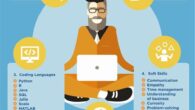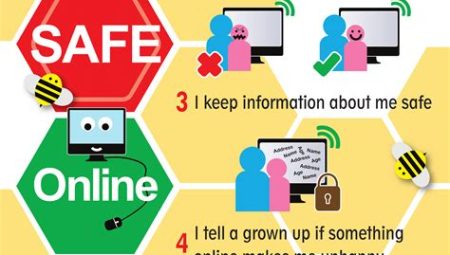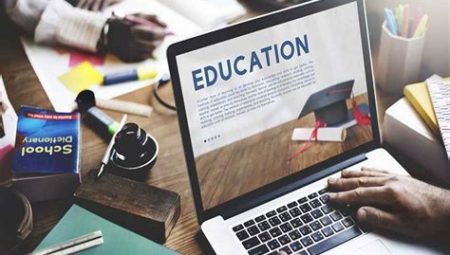Are you curious about the latest advances in educational technologies and how they are shaping the future of learning? In this blog post, we will dive into the cutting-edge developments that are revolutionizing the way students learn and educators teach. From virtual reality transforming learning experiences to artificial intelligence enabling personalized learning, we will explore how these technologies are reshaping the educational landscape. Gamification, augmented reality, the Internet of Things, adaptive learning platforms, robotics, mobile learning, cloud-based collaboration tools, and big data analytics are also among the topics we will cover. Join us as we unveil the transformative potential of these technologies and their impact on education, empowering students to learn anytime, anywhere, and educators to make informed decisions that cater to individual student needs. Whether you’re an educator, student, or technology enthusiast, this blog post is a must-read for anyone interested in the future of education.
Table of Contents
Virtual Reality: Transforming Learning Experiences
Virtual reality (VR) technology has revolutionized the way we learn and experience new information. With VR, students are no longer confined to traditional classroom settings, but rather can immerse themselves in a virtual environment that brings learning to life. Imagine being able to explore the depths of the ocean, travel back in time to historical events, or even visit outer space, all from the comfort of your classroom.
One of the key benefits of virtual reality in education is its ability to engage students in a way that traditional methods cannot. By providing an immersive and interactive experience, VR captures students’ attention and makes learning more exciting and memorable. Students who may struggle with traditional teaching methods may find that they excel in a VR environment, as it appeals to a broader range of learning styles.
Moreover, virtual reality allows for hands-on learning experiences without the need for expensive equipment or field trips. Students can interact with simulations and 3D models that would be impossible to replicate in a traditional classroom setting. This not only saves costs but also opens up new possibilities for learning across various subjects, from science and history to art and engineering.
As technology continues to advance, the potential for virtual reality in transforming learning experiences is boundless. With ongoing developments and improvements, VR has the power to make education more accessible, engaging, and impactful for students of all ages and backgrounds.
Artificial Intelligence in Education: Personalized Learning
Artificial intelligence (AI) is revolutionizing the way education is delivered, particularly through personalized learning. With the advancement of AI technology, educators can now tailor lessons and content to individual student needs, providing a more customized and effective learning experience. AI algorithms analyze each student’s learning patterns and preferences, allowing educators to create a personalized curriculum that suits their unique strengths and weaknesses.
Furthermore, AI in education enables students to receive real-time feedback on their performance, identifying areas for improvement and offering targeted support. This individualized approach to learning not only enhances academic achievement but also boosts students’ self-esteem and motivation, as they are more likely to engage with material that is tailored to their specific needs.
Through AI-powered adaptive learning platforms, educators can cultivate a student-centered learning environment, where each student’s progress is closely monitored and supported. This fosters a sense of ownership over their learning journey and encourages students to take an active role in their education.
In conclusion, the integration of AI in education holds immense potential for personalized learning experiences that cater to individual student needs, ultimately nurturing a more engaged and empowered student body.
Gamification: Engaging Students through Interactive Learning
Gamification is a powerful tool that has been proven to engage students and enhance their learning experiences. By incorporating game elements such as points, levels, and rewards into educational activities, educators can create a more interactive and enjoyable learning environment for their students.
Through gamification, students are motivated to actively participate in their own learning process, as they are driven by the desire to earn rewards and progress through the levels. This not only makes learning more fun, but also encourages students to take ownership of their education and pushes them to excel.
Furthermore, gamification fosters collaboration and healthy competition among students, as they can work together to achieve goals and compare their progress with their peers. This not only enhances their social skills, but also teaches them important life lessons such as teamwork and sportsmanship.
Overall, gamification has the potential to revolutionize the way students learn by making the educational experience more interactive, engaging, and rewarding for everyone involved.
Augmented Reality: Enhancing Classroom Instruction
Augmented Reality (AR) has the potential to transform traditional classroom instruction into an engaging and interactive learning experience for students. By incorporating AR technology into lessons, educators can bring abstract concepts to life and create a more immersive learning environment.
With the use of AR apps and devices, students can visualize complex 3D models, explore historical landmarks, and even interact with virtual objects in real-time. This hands-on approach to learning not only enhances student engagement but also improves retention and understanding of the material.
Furthermore, AR allows for personalized instruction by catering to different learning styles and paces. Students can explore content at their own speed, delve deeper into topics of interest, and receive instant feedback on their progress. This level of customization in learning can lead to improved academic performance and overall student satisfaction.
By integrating AR technology into the classroom, educators can create a dynamic and interactive learning environment that fosters creativity, critical thinking, and collaboration. As the use of AR continues to evolve, its potential to enhance classroom instruction and student learning experiences is truly limitless.
Internet of Things: Revolutionizing Educational Settings
The Internet of Things (IoT) is rapidly transforming the educational landscape, bringing about a paradigm shift in the way learning environments operate. By connecting devices and sensors through the internet, IoT is revolutionizing educational settings, enhancing efficiency, and creating more personalized learning experiences.
One of the key benefits of IoT in education is the ability to monitor and manage educational facilities in real time. This means that school administrators can track the usage of resources such as energy, water, and equipment, leading to more sustainable and cost-effective management. Smart classrooms equipped with IoT devices can also automate tasks such as attendance tracking, environmental control, and security monitoring, allowing educators to focus more on teaching and less on administrative tasks.
Moreover, IoT enables personalized learning experiences by gathering data on students’ learning habits and preferences. This data can be used to tailor teaching strategies and content delivery to meet the individual needs of students, ultimately leading to improved learning outcomes. For example, IoT devices can track students’ progress, identify areas for improvement, and provide targeted learning materials and support.
Overall, the integration of IoT in educational settings is reshaping the way students learn and teachers teach. With the ability to connect and interact with various devices and systems, IoT is fostering a more efficient, sustainable, and personalized approach to education, ultimately preparing students for the technologically advanced world they will encounter beyond the classroom.
Adaptive Learning Platforms: Tailoring Lessons to Students’ Needs
Adaptive learning platforms are revolutionizing the way students learn, by personalizing lessons to fit their individual needs. These platforms utilize artificial intelligence algorithms to analyze each student’s learning patterns and preferences, and tailor the content and pace of instruction accordingly.
By personalizing lessons, adaptive learning platforms can provide a more engaging and effective learning experience for students of all levels and abilities. For example, a student struggling with a particular concept can receive additional practice and support, while a student who grasps the material quickly can move on to more challenging tasks.
Furthermore, these platforms allow educators to monitor students’ progress in real time, enabling them to provide timely interventions and support as needed. This level of individualized attention can significantly improve students’ learning outcomes and overall academic success.
In conclusion, adaptive learning platforms are playing a crucial role in tailoring lessons to students’ needs, and are helping to create a more personalized and effective educational experience for learners of all backgrounds and abilities.
Robotics in Education: Preparing Students for the Future
In today’s rapidly changing world, it is important for students to be equipped with the necessary skills to succeed in the future. One of the ways educational institutions are preparing their students for the future is by integrating robotics into their curriculum.
By introducing students to robotics at an early age, they are not only learning about the technical aspects of coding and programming, but they are also developing critical thinking, problem-solving, and teamwork skills. These are essential skills that will be invaluable as they enter the workforce in a world that is increasingly driven by technology.
Furthermore, the integration of robotics in education allows students to explore and understand STEM concepts in a practical and interactive way. This hands-on approach to learning not only makes STEM subjects more engaging, but it also helps students to see the real-world applications of what they are learning.
As the demand for workers with STEM-related skills continues to grow, it is clear that robotics in education is playing a crucial role in preparing students for the future job market. By fostering a love for engineering and technology at a young age, students are better equipped to pursue careers in these fields, ultimately contributing to the advancement of society as a whole.
Mobile Learning: Empowering Education Anytime, Anywhere
Mobile learning, also known as m-learning, is revolutionizing the way students and educators engage with educational content. With the widespread use of smartphones and tablets, learning is no longer confined to the traditional classroom setting. Students now have the ability to access educational materials and resources anytime, anywhere, at their convenience.
Mobile learning offers flexibility and accessibility, allowing students to learn at their own pace and in their own space. Whether it’s through educational apps, video lectures, or interactive quizzes, mobile learning empowers students to take control of their own learning journey.
Furthermore, mobile learning enables educators to create engaging and interactive content that caters to different learning styles. With the use of multimedia elements such as images, videos, and audio clips, educators can make learning more dynamic and appealing to students.
Overall, mobile learning has the potential to democratize education by making it accessible to a wider audience, bridging the gap between traditional and digital learning environments. It offers a new paradigm of education that transcends the limitations of physical classrooms, empowering education anytime, anywhere.
Cloud-based Collaboration Tools: Enhancing Communication in Education
Cloud-based collaboration tools have revolutionized the way communication takes place in the field of education. By providing a platform for seamless interaction and sharing of resources, these tools have significantly enhanced the overall learning experience for both students and educators.
The use of cloud-based collaboration tools allows for real-time communication and collaboration, regardless of geographical barriers. This means that students and educators can easily connect and work together on projects, assignments, and research, without being limited by physical distance.
Furthermore, these tools also enable easy sharing of resources such as documents, presentations, and multimedia content. This fosters a more dynamic and interactive learning environment, where information can be accessed and utilized by all parties involved, at any time and from any location.
Overall, cloud-based collaboration tools play a vital role in breaking down communication barriers in education, and are instrumental in creating a more connected and collaborative learning community.
Big Data Analytics: Informing Decision-Making in Education
Big Data Analytics is revolutionizing the way decisions are made in the field of education. With the help of big data analytics, educators and administrators are able to make more informed and data-driven decisions when it comes to student performance, resource allocation, and curriculum development. By analyzing large volumes of data, such as student attendance records, test scores, and behavioral patterns, educational institutions are able to gain valuable insights into the strengths and weaknesses of their programs and make strategic improvements.
Furthermore, big data analytics allows for greater personalization in education. By tracking individual student progress and learning styles, educators can tailor their teaching methods to better meet the needs of each student. This personalized approach to education can lead to improved student outcomes and a more engaging learning experience.
In addition, big data analytics can also be used to identify at-risk students who may need additional support. By analyzing various data points, such as attendance, grades, and disciplinary records, educators can identify early warning signs and intervene before a student’s academic performance deteriorates further.
Overall, big data analytics is proving to be a valuable tool in education, providing insights that can inform decision-making, improve student outcomes, and enhance the overall learning experience.





